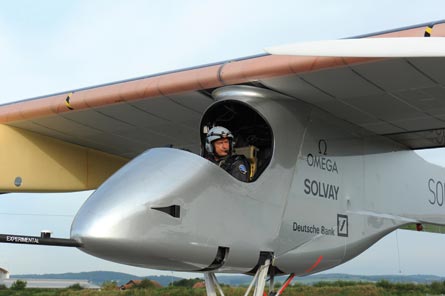A chat with Andre Borschberg is a throwback to the early days of aviation when - with a combination of aeronautical aptitude, persuasive powers and adventurism - pioneers turned their radical ideas into flight. Borschberg and his business partner, round-the-world balloonist Bertrand Piccard, aim to create in Switzerland a single-pilot aircraft capable of circumventing the globe by 2012, powered only by the sun.
Their enterprise, Solar Impulse, has already achieved a 26h solar-powered flight in July, with Borschberg taking off from Payerne air base in Switzerland in a four-engined prototype and flying over the Alps. They are now adapting that prototype, HB-SIA, into a larger more robust version, with advanced avionics and possibly a pressurised cockpit, capable of staying aloft for stretches of up to 100h, an on-board battery charging by day and powering the aircraft by night. They plan to make their first "international" flight, of up to two days, next year.
|
|---|
The aim of the project - which is backed by the Swiss university EPFL in Lausanne as well as international sponsors including Deutsche Bank and Dassault - is about more than proving sustained solar-powered flight in a manned aircraft is possible. It is about sparking new thinking into alternative fuels.
"We don't want to make people believe that we can all fly in solar-powered airliners in future," says Borschberg, an entrepreneur, engineer and veteran of the Swiss air force. "Our main purpose is to promote the message that air transport must develop different solutions. What is affordable today might not be tomorrow."
|
|---|
While Borschberg believes solar power can play a role in future environmental solutions to powering aircraft, he acknowledges there are many obstacles, including the fact that 35kg (77lb) of batteries are needed to provide the energy of 1kg of jet fuel. While the Solar Impulse aircraft gets around this with an ultra-lightweight carbonfibre design (the current 63.4m (208ft)-wingspan prototype weighs just 1,600kg, 450kg of that the lithium ion batteries which run the four electric motors), Borschberg believes that hybrid technologies could be crucial in future, perhaps with solar-powered cells providing energy for aircraft on the ground.
There are human and regulatory as well as technological challenges to be overcome in achieving a round-the-world flight. As with many of the early aviators, the need to sleep on a long-distance solo flight that requires regular airmanship is a concern. Although the version used for the global attempt will have an autopilot, Borschberg is already training himself to power nap, sleeping for 15min every 3-4h. The flightpath will also have to be carefully worked out in advance with many air traffic authorities, with Borschberg flying at 28,000ft during the day and descending to 5,000ft at sunset.
Although Solar Impulse is an international effort, Borschberg is proud of the central role of Switzerland. "It is a key project for the country," he says. "It shows Switzerland can be innovative. Normally all crazy aeroplane designs come from the USA."
Source: Flight International






















